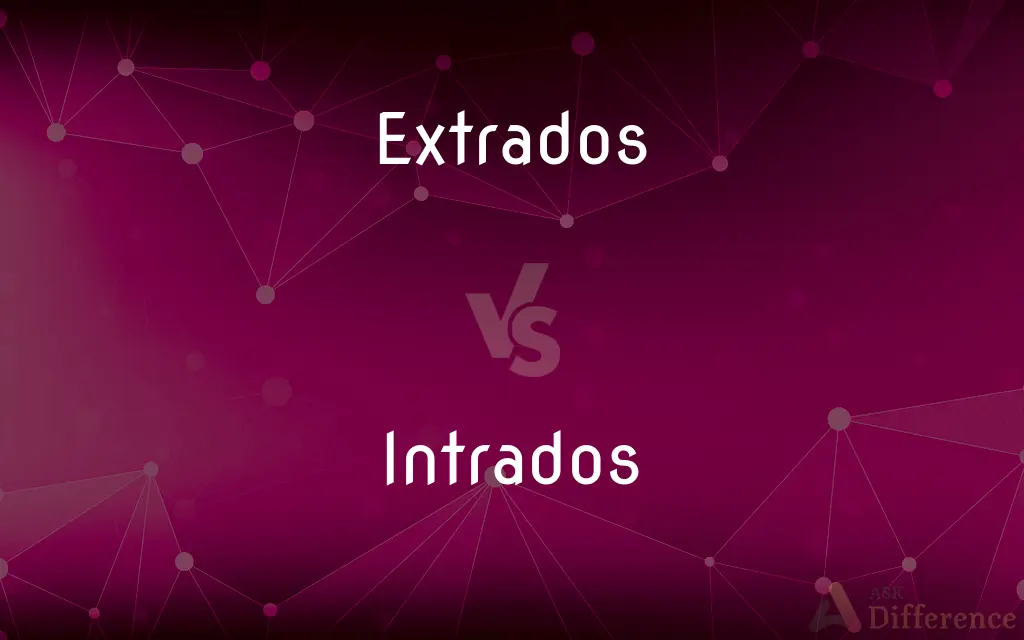Extrados vs. Intrados — What's the Difference?
By Tayyaba Rehman & Maham Liaqat — Updated on May 3, 2024
The extrados is the outer curve or surface of an arch, facing away from the enclosed space, while the intrados is the inner curve or surface, facing the space enclosed by the arch.

Difference Between Extrados and Intrados
Table of Contents
ADVERTISEMENT
Key Differences
Extrados refers to the external curve of an arch, visible from the outside and forming the arch's topmost boundary. It is crucial in defining the arch's aesthetic and structural profile, often exposed to environmental conditions. On the other hand, the intrados is the interior surface, visible from within the space the arch encloses, and is essential for the arch's functional design, influencing how the space beneath is experienced.
While the extrados often deals with the structural integrity and the external forces acting upon an arch, such as weathering or external loads, the intrados plays a critical role in the distribution of weight and internal forces within the arch structure. This makes the intrados vital for maintaining the stability of the arch.
In terms of construction and aesthetic detail, the extrados may be adorned or left plain, depending on the architectural style and purpose. Conversely, the intrados is more likely to feature decorative elements, especially in historical or significant architectural works, where it contributes to the visual and atmospheric qualities of the space.
The extrados's curvature and finish can vary widely, sometimes being part of complex designs involving multiple arches or additional architectural elements like flying buttresses. The intrados, however, typically focuses on ergonomic and visual comfort, influencing how people feel within the arch's space.
From a technical perspective, the shape and angle of the extrados can affect the overall dynamics and load-bearing capabilities of an arch. In contrast, the intrados directly impacts the acoustic and lighting conditions of the enclosed area, playing a significant role in architectural acoustics and lighting.
ADVERTISEMENT
Comparison Chart
Position
Outer surface of an arch
Inner surface of an arch
Structural Role
Deals with external forces and integrity
Distributes internal weight and forces
Aesthetic Impact
External appearance and profile
Interior design and atmosphere
Decorative Details
Varies, often minimal
Frequently features detailed ornamentation
Influence on Arch Dynamics
Shapes dynamics and stability
Affects interior acoustics and lighting
Compare with Definitions
Extrados
The outer curve or surface of an arch, often facing the environment.
The extrados of the Roman aqueduct remains intact despite centuries of exposure.
Intrados
The inner curve or surface of an arch, facing the space it encloses.
The intrados of the bridge was painted a vibrant blue to enhance its aesthetic appeal.
Extrados
Crucial for the structural integrity of arch-based constructions.
Engineers assessed the extrados for cracks to ensure the arch’s stability.
Intrados
Plays a key role in the internal distribution of forces within the arch.
Structural analysis focused on the intrados to understand pressure points within the arch.
Extrados
Subject to external environmental conditions, influencing its design and materials.
The extrados was finished with a waterproof coating to protect the arch from rain.
Intrados
Important for the functional use of the space beneath the arch.
The smooth finish of the intrados improved the acoustic properties of the archway.
Extrados
May be simple or complex depending on architectural requirements.
The cathedral’s extrados featured intricate carvings that told stories from the scriptures.
Intrados
Often features artistic or ornamental work, especially in significant buildings.
The gothic church featured a beautifully sculpted intrados depicting biblical scenes.
Extrados
Can be part of a system involving other structural supports.
The extrados worked in conjunction with flying buttresses to distribute the load.
Intrados
Directly impacts the light distribution and acoustics within the enclosed space.
The curvature of the intrados was designed to optimize light reflection into the interior.
Extrados
The upper or exterior curve of an arch.
Intrados
The inner curve of an arch.
Extrados
(architecture) The outer or upper curve of an arch.
Intrados
(architecture) The inner curve of an arch or vault.
Extrados
The exterior curve of an arch; esp., the upper curved face of the whole body of voussoirs. See Intrados.
Intrados
The interior curve of an arch; esp., the inner or lower curved face of the whole body of voussoirs taken together. See Extrados.
Extrados
The exterior curve of an arch
Intrados
The interior curve of an arch
Common Curiosities
How do the roles of the extrados and intrados differ in arch stability?
The extrados helps manage external loads and environmental impacts, while the intrados distributes internal forces crucial for arch stability.
Why is the intrados often more decorative than the extrados?
The intrados directly affects the atmosphere and aesthetic of the space it encloses, often leading to more detailed ornamentation.
What determines the shape of an extrados?
The extrados shape is influenced by architectural style, structural needs, and external environmental factors.
What maintenance challenges are associated with the extrados of historical arches?
Weathering and environmental damage can lead to deterioration, requiring specialized restoration techniques.
How can the design of the intrados influence a building’s energy efficiency?
The intrados can affect how light is distributed within a space, potentially reducing the need for artificial lighting and enhancing energy efficiency.
Can the intrados and extrados of an arch have different materials?
Yes, often different materials or finishes are used on the intrados and extrados to fulfill aesthetic or functional requirements.
What are some structural engineering considerations for the extrados in earthquake-prone areas?
In earthquake-prone areas, the extrados must be designed to withstand seismic forces, often involving flexible materials or additional reinforcements.
How do the materials used for the extrados and intrados compare in terms of cost?
Material choices are often driven by both cost and functionality, with exterior materials possibly requiring more durable, higher-cost options.
What historical examples show the importance of intrados in architectural design?
The Roman and Ottoman architectures provide clear examples where the intrados was central to both design and functionality.
What architectural styles emphasize the decoration of the intrados?
Gothic, Romanesque, and Baroque architectures often feature highly decorated intradoses to enhance interior spaces.
Are there any modern uses of arches where intrados and extrados designs are particularly important?
In modern acoustic and theatre architecture, the design of both the intrados and extrados is crucial for optimal sound distribution and visual impact.
How is the visual harmony between an arch’s intrados and extrados achieved in modern architecture?
Modern architecture often uses complementary materials and designs to achieve visual harmony between the intrados and extrados, ensuring aesthetic and structural cohesion.
How does the design of an extrados affect an arch’s durability?
The design and material of the extrados can impact its resistance to environmental damage and structural wear.
Can the intrados of an arch be modified for better functionality without affecting the extrados?
Modifications to the intrados, like adding acoustic panels or lighting fixtures, can be done without altering the extrados.
What safety measures are considered in the maintenance of an extrados?
Safety measures include regular inspections, structural assessments, and the use of weather-resistant materials to prevent degradation.
Share Your Discovery

Previous Comparison
Dualism vs. Binary
Next Comparison
Target vs. PointAuthor Spotlight
Written by
Tayyaba RehmanTayyaba Rehman is a distinguished writer, currently serving as a primary contributor to askdifference.com. As a researcher in semantics and etymology, Tayyaba's passion for the complexity of languages and their distinctions has found a perfect home on the platform. Tayyaba delves into the intricacies of language, distinguishing between commonly confused words and phrases, thereby providing clarity for readers worldwide.
Co-written by
Maham Liaqat















































